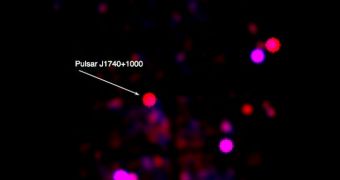A special class of neutron stars called pulsars could feature radiation belts around them, the results of a new study published in the August 24 issue of the top journal Science indicate. From this perspective, the objects would be similar to Earth, which is surrounded by the two Van Allen radiation belts.
Neutron stars are born when massive stars reach the end of their main sequence, and explode as supernovae. If the stellar precursor had sufficient mass, its core will collapse into a black hole, and then go on to consume everything around it.
However, if insufficient mass is present before the supernova event, the core will collapse into a neutron star, which is less dense than a black hole. Still, a single tablespoon of material from such an object weighs in excess of 100 trillion tons, or roughly as much as a mountain.
Pulsars are special neutron stars in the sense that they release jets from their poles that are oriented towards our planet. We perceive these jets just like a ship's captain sees a rotating lighthouse in the distance, hence the name.
In the recent study, experts found that a few weird pulsars appear to show signs of light absorption around them, consistent with the presence of an atmosphere. However, it is known that these objects cannot support a permanent atmosphere around them.
In addition, the anomalous structures lack the strong magnetic fields that characterize neutron stars. The team behind the new work says that the only feasible interpretation of the data is the presence of radiation belts around these objects.
The work was led by astrophysicists at the University of Florida in Gainesville, the Monash University in Melbourne, Pennsylvania State University, George Washington University and the St. Petersburg State Polytechnic University, in Russia.
“Here, we report the detection of absorption features in the X-ray spectrum of an ordinary rotation-powered radio pulsar, J1740+1000,” the team writes in the Science paper, as quoted by ArsTechnica.
“Our findings bridge the gap between the spectra of pulsars and other, more exotic, NSs [nonaccreting neutron stars], suggesting that the features are more common in the NS spectra than they have been thought so far,” the researchers go on to say.

 14 DAY TRIAL //
14 DAY TRIAL //